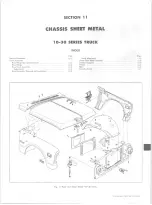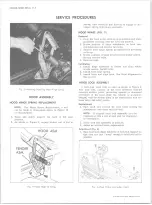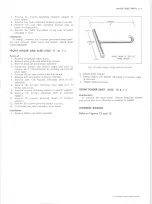
WHEELS AND TIRES 10-2
t r e a d
t r e a d
STILL G O O D
W O RN OUT
Fig. 3 — Passenger Type Tire Tread W e ar Indicator
Tread Wear
When the depth of tread becomes 1/16-inch or less,
there is a significant decrease in traction and anti-skid
properties, also, the majority of tire troubles will occur
in the last 10% of tire life.
The original equipment passenger type tires on Series
10 trucks incorporate built in tread indicators to assist
in judging when tires are worn out and should be re
placed.
These indicators are molded into the bottom of the
tread groove and will appear as bands across the tread
as a visual reminder that the tire should be replaced
(see fig. 3).
MAINTENANCE
WHEEL NUT TORQUES
On a new vehicle or after the wheel has been changed,
the wheel nut torque must be checked at 100, 1,000 and
6,000 miles and every 6,000 miles thereafter.
TIRE ROTATION
The rotation of truck tires will minimize tire trouble
and produce longer tire life. ;With rotation, accelerated
and irregular tire wear on any One particular tire will
be spread out over the entire set, and replacement fre
quency will be reduced. Tire wear may also contribute
to such trouble as poor handling and shimmy.
No definite tire rotation formula is applicable to all
trucks because of the wide range of usage. However,
certain fundamentals, mixed with experience and obser
vation, will assist the trucker in reducing tire costs.
A rotation sequence that moves the front tires to the
rear is a general recommendation. Due to different
loading conditions on the wheels, new tires which are
broken in on the front wheels usually produce the great
est overall tire life.
The outer tire on a dual wheel will skid or drag on a
turn because of the difference in the turning radii of the
inner and outer tires. This results in faster wear of the
outer tire. In general, the tire with the largest diameter
or least wear should be at the outside of each dual wheel.
In addition, certain truckers have found when trucks are
operated continuously on high crown roads an increase
in air pressure of from 5 to 10 pounds in the outside tire
of each dual produces maximum tire life.
To equalize wear it is recommended that the tires be
rotated every 6,000 miles. Upon rotation, tire pressure
must be adjusted (front and rear) in accordance with the
recommendations in the "Tire Load and Inflation Pres
sure" table.
Inflation Pressure
Standard inflation pressures for tires are listed in the
"Load Capacity Chart" in the Section 0, "General Infor
mation," in this manual. These are the minimum re
quired tire pressures for maximum permissible loads.
The use of improper tire inflation pressures can affect
tire life and load carrying capacity, and may affect ve
hicle handling. Inflation pressures should be checked at
least once a month (and preferably more often) to insure
that the right amount of air is contained in the tires.
With regard to tire life, too little air pressure allows
abnormal deflection of the tire causing excessive operat
ing temperatures, while too much air pressure prevents
normal deflection, making the cord body more vulnerable
to road impacts.
Use of optional inflations is allowable only with a re
duced load.
When operating at loads greater than the optional re
duced load, the inflation pressure must be increased to
the standard inflation for full rated loads.
TIRE LOAD AND INFLATION PRESSURE
Inflation pressures shown below for passenger type tires are for normal ride
and handling use. Pressures may be required up to a maximum of 32 psi cold
for load range B tires or 36 psi cold for load range C tires for maximum load
carrying capacity.
M O D E L
M ax. G ro s s
Ve hicle Wgt.
[Incl. P a s s e n g e r s )
T ire Size
& Load R a n g e
In fla tion P re ssu re
P S I (C o ld )
Front
Rear
P I C K U P S AND C A B S
CS/CE10
4400
5400
G78-15 B
30
32
6.50-16 C
30
34
H78-15 B
30
32
K S / K E 107-109
5200
G78-15 B
30
32
6.50-16 C
30
34
5600
H78-15 B
30
32
FORW ARD C O N T R O L ( S T E P VAN S )
PS/PE10
4600
5300
5400
G78-15 B
30
32
6.50-16 C
30
34
H78-15 B
30
32
B L A Z E R M O D E L S
(F rt. Seat Only)
2 Passenger
*+ 4 5 0 # Cargo
-
E78-15 B
30
32
(F rt. Seat Only)
2 Passenger
*+ 850# Cargo
-
G78-15 B
30
32
H78-15 B
30
32
6.50-16 C
30
32
*Cargo load reduced by 225# when the vehicle is equipped with hard top.
S U B U R B A N S
C S /C E 1 to 3 Pass.
(1 Seat)
+ 3 0 0 lbs. Cargo
-
G78-15 B
30
32
6.50-16 C
30
36
1 to 5 Pass. (2 Seat)
+ 6 0 0 lbs. Cargo
1 to 9 Pass. (3 Seat)
-
H78-15 B
30
32
ALS O R E F E R TO “ T I R E L O A D AN D I N F L A T I O N P R E S S U R E
T A B L E N O T E S ” 1 T H R O U G H 8.
10-30 CHEVROLET TRUCK SERVICE MANUAL
Summary of Contents for 10 1971 Series
Page 1: ......
Page 96: ......
Page 100: ...10 30 CHEVROLET TRUCK SERVICE MANUAL Fig 4 10 30 Series Truck Frame FRAME 2 4 ...
Page 120: ......
Page 203: ...ENGINE 6 25 Fig 22L Engine Mounts 10 30 CHEVROLET TRUCK SERVICE MANUAL ...
Page 215: ...ENGINE 6 37 REAR M O U NT Fig 21V Engine Mounts 10 30 CHEVROLET TRUCK SERVICE MANUAL ...
Page 218: ......
Page 249: ......
Page 324: ......
Page 340: ......
Page 365: ...10 30 CHEVROLET TRUCK SERVICE MANUAL Fig 43 Power Steering Pump M ounting STEERING 9 25 ...
Page 368: ......
Page 386: ......
Page 390: ...ELECTRICAL BODY AND CHASSIS 12 4 10 30 CHEVROLET TRUCK SERVICE MANUAL ...
Page 391: ......
Page 428: ......
Page 432: ......
Page 449: ...SPECIFICATIONS 9 10 30 CHEVROLET TRUCK SERVICE MANUAL ...
Page 463: ......
Page 464: ......
Page 465: ......
Page 466: ......

































